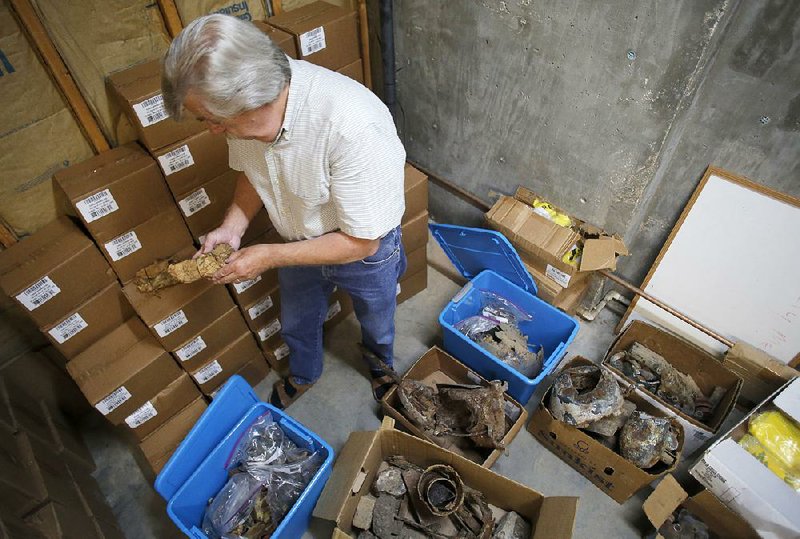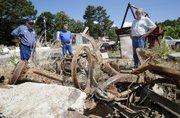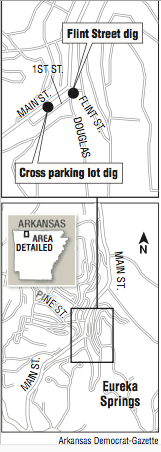EUREKA SPRINGS -- Remains have been exhumed on Main Street.
Not human remains.
They appear to be the rusted remnants of Model T Fords.
The cars were buried in a gulch alongside Main Street in 1928.
"There was an old garage back here," said Dwayne Allen, Eureka Springs' public works director. "They were filling [the gulch] in with whatever was handy, and they probably needed to get rid of them."
The cars and other century-old artifacts were excavated last month so a section of tunnel could be repaired. The tunnel was built in the 1920s so East Leatherwood Creek could flow underground, allowing construction of parking lots above ground for automobiles, which were becoming increasingly popular at the time.
The excavation temporarily removed a section of Flint Street, which intersects Main Street just north of the Grand Central Hotel.
Mayor Robert "Butch" Berry said he was surprised when workers found the cars underground.
"I always said these hillbillies would throw anything in these valleys, fill them up with a couple of feet of dirt and call them flat, but I never thought about a car!" said Berry, who is a Eureka Springs native.
Finding a car underground was a new experience for Jake Mitchael, an archaeologist with Flat Earth Archeology of Cabot, the firm hired to monitor the dig.
"I've never excavated a car," he said. "To see them used as actual fill is unique."
Archaeologists have speculated that the cars are Model T's, but that has yet to be determined. More than 15 million Model T's were built over the auto's 19-year run from 1908 to 1927.
The excavated cars, or at least parts of them, have been hauled up to the public works department on U.S. 62. They're in pieces behind the building. There are two engines -- one with 8-21-19 on the side -- frame parts, two license plates and a wheel sprocket with the jagged remnants of wooden spokes. The wheel was intact when workers found it but broke apart during the excavation.
"We weren't trying to salvage and save artifacts," said Berry. "This wasn't an archaeological dig. This was a construction project, and unfortunately that big backhoe was pretty indiscriminate in what it grabbed hold of."
State and federal regulations required an archaeologist to be on-site during the excavation, said Glenna Booth, Eureka Springs' historic preservation officer. Most of the city is listed on the National Register of Historic Places.
Allen said he would like to reassemble one of the cars and see it in a museum.
"We're going to make something out of this," he said. "Here, nobody's going to see it. We want to make something the public can see."
He'll have some reconstructing to do.
"You're missing a lot of body panels, the rear end, stuff like that," said Mitchael.
The mayor suspects Allen was kidding about reconstructing one of the cars. Not enough of the parts are available.
"We might get a local artist to make something out of them," said Berry.
Mitchael said the excavation itself was unique because it was completely infill material. He said no prehistoric artifacts were found at the site.
"We found a lot of things you would expect to find in a dump," he said. "It's what a lot of archaeology is -- a lot of sorting through people's waste, people's trash, from a long time ago."
The excavation unearthed streetcar rails, a mechanical press and parts of a cast iron stove. Among the smaller items were old bottles -- including Listerine and Milk of Magnesia -- and readable 1928 newspaper fragments from the Oklahoma City Times and Southwest American of Fort Smith.
The Eureka Springs Auditorium was built on Main Street in 1928. Berry said that may have spurred other improvements in the area that year.
Filling in the gulch around East Leatherwood Creek to allow for construction of a parking lot above might have sounded like a good idea at the time, said Berry, who is an architect.
"We don't have any flat land," he said. "That's why Eureka is limited in its growth. It's probably one of the more challenging communities to build in in Arkansas."
"Eureka Springs is a remarkable place to have that old architecture still standing in that precarious environment," Mitchael said of the city's buildings. "There was some bold engineering going on."
The excavation at Flint Street is just down Main Street from an excavation to repair a different section of the same tunnel. On June 1, the pavement of a parking lot owned by John Cross began to give way. It has resulted in a major excavation and replacing that section of the tunnel.
The Flint Street excavation had been planned for months. The excavation started June 18 and ended June 26, said Mitchael. Berry said Davis Construction of Harrison is the general contractor on the tunnel work at Flint Street, which should be completed in a couple of weeks. The project was estimated to cost $238,755.
Berry said the fill dirt over the tunnel wasn't properly compacted. As organic material in the fill gives way, things above ground sink. Berry said they're not really "sinkholes" because they're man-made problems.
Mitchael said what appears to be a moonshine jug was found 17 feet below Flint Street.
Berry has it in his office. He envisions someone driving a car into the gulch after taking a few swigs from the bottle, then just leaving it all there.
A Section on 07/08/2018



